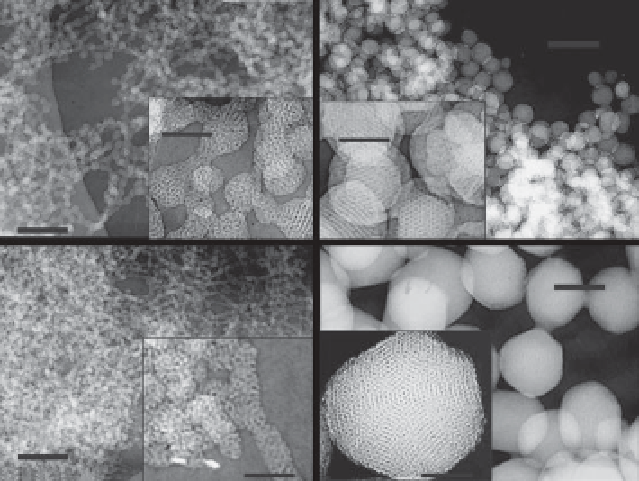Biomedical Engineering Reference
In-Depth Information
100 nm
20 nm
20 nm
100 nm
100 nm
100 nm
20 nm
20 nm
Figure 13.8
TEM images of the nanospherical MCM-41 silica with an average
size of about 10 nm, 20 nm, 40 nm, 100 nm was produced through reaction of
extremely low surfactant concentrations of CTAB with TEOS in the sodium
hydroxide medium at 353 K. insert is the high resolution transmission electron
microscopy (HRTEM) image of the sample. (Reprinted with permission from [56])
with that of MCM-41, and periodic mesopores fringes are 120 nm.
The BET (Brunauer-Emmett-Teller model) specifi c surface area and BJH
(Barrett-Joyner-Halenda model) pore size of the samples are 784 m
2
g
−1
and 2.36 nm, respectively.
13.4.2.2
Ether-Water System: Mesoporous Vesicles
An oil-water, two-phase system is introduced in this section, the interface
of the ether-water and the microemulsion can be as the template. In ether-
water system, a series of vivid morphologies can be obtained, and the key
point is using the unstable oil-water interface as the template. Because
the ether is an oil phase with low boiling temperature, the interface of
ether and water is easy to change. Various morphologies, such as radio-
larian-like silica sphere with hollow inner, and so on, have been prepared.
A radiolarian-like silica sphere has been prepared in a water-ether binary
solvent system. The results indicate its particular morphology and hier-
archical structure, i.e., hollow interior and a crust wherein two types of
mesopores with radial orientation are located. This silica product embod-
ies a novel morphosynthesis involving unstable water-oil interface [60].
In this system, six kinds of morphologies can be synthesized and have
been classifi ed. The TEM images of each kind of morphology can show that
they are mesoporous silica vesicles, mesoporous silica particle (including

Search WWH ::

Custom Search